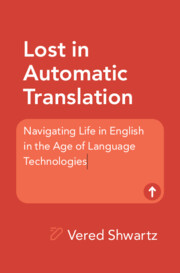Refine search
Actions for selected content:
3312 results in Artificial Intelligence and Natural Language Processing
11 - Challenges of Generative AI on Human–AI Interaction and Collaboration
-
-
- Book:
- Human-AI Interaction and Collaboration
- Published online:
- 19 September 2025
- Print publication:
- 09 October 2025, pp 268-283
-
- Chapter
- Export citation

Lost in Automatic Translation
- Navigating Life in English in the Age of Language Technologies
-
- Published online:
- 08 October 2025
- Print publication:
- 21 August 2025
17 - Military Applications of Artificial Intelligence Metacognition
- from Part VIII - Applications of Metacognitive AI
-
-
- Book:
- Metacognitive Artificial Intelligence
- Published online:
- 08 September 2025
- Print publication:
- 25 September 2025, pp 276-296
-
- Chapter
- Export citation
8 - Metacognitive Insights into ChatGPT’s Arithmetic Reasoning
- from Part IV - Metacognition with LLMS
-
-
- Book:
- Metacognitive Artificial Intelligence
- Published online:
- 08 September 2025
- Print publication:
- 25 September 2025, pp 121-132
-
- Chapter
- Export citation
Frontmatter
-
- Book:
- Metacognitive Artificial Intelligence
- Published online:
- 08 September 2025
- Print publication:
- 25 September 2025, pp i-iv
-
- Chapter
- Export citation
2 - An Architectural Approach to Metacognition
- from Part II - Taxonomy of Metacognitive Approaches
-
-
- Book:
- Metacognitive Artificial Intelligence
- Published online:
- 08 September 2025
- Print publication:
- 25 September 2025, pp 25-43
-
- Chapter
- Export citation
11 - Toward Certifiably Trustworthy Deep Learning at Scale
- from Part VI - Assured Machine Learning in High-Stakes Domains
-
-
- Book:
- Metacognitive Artificial Intelligence
- Published online:
- 08 September 2025
- Print publication:
- 25 September 2025, pp 185-211
-
- Chapter
- Export citation
Contents
-
- Book:
- Metacognitive Artificial Intelligence
- Published online:
- 08 September 2025
- Print publication:
- 25 September 2025, pp v-vii
-
- Chapter
- Export citation
12 - Metacognition with Neural Network Verification and Repair Using Veritex
- from Part VI - Assured Machine Learning in High-Stakes Domains
-
-
- Book:
- Metacognitive Artificial Intelligence
- Published online:
- 08 September 2025
- Print publication:
- 25 September 2025, pp 212-228
-
- Chapter
- Export citation
13 - Reasoning about Anomalous Object Interaction Using Plan Failure as a Metacognitive Trigger
- from Part VII - Metacognition as a Solution to Handle Failure
-
-
- Book:
- Metacognitive Artificial Intelligence
- Published online:
- 08 September 2025
- Print publication:
- 25 September 2025, pp 231-244
-
- Chapter
- Export citation
Part VII - Metacognition as a Solution to Handle Failure
-
- Book:
- Metacognitive Artificial Intelligence
- Published online:
- 08 September 2025
- Print publication:
- 25 September 2025, pp 229-230
-
- Chapter
- Export citation
16 - mLINK: Machine Learning Integration with Network and Knowledge
- from Part VIII - Applications of Metacognitive AI
-
-
- Book:
- Metacognitive Artificial Intelligence
- Published online:
- 08 September 2025
- Print publication:
- 25 September 2025, pp 264-275
-
- Chapter
- Export citation
Part VI - Assured Machine Learning in High-Stakes Domains
-
- Book:
- Metacognitive Artificial Intelligence
- Published online:
- 08 September 2025
- Print publication:
- 25 September 2025, pp 183-184
-
- Chapter
- Export citation
6 - Assessment of Competency of Learning Agents via Inference of Temporal Logic Formulas
- from Part III - Neuro-Symbolic Models in AI
-
-
- Book:
- Metacognitive Artificial Intelligence
- Published online:
- 08 September 2025
- Print publication:
- 25 September 2025, pp 95-108
-
- Chapter
- Export citation
14 - Tractable Probabilistic Reasoning for Trustworthy AI
- from Part VII - Metacognition as a Solution to Handle Failure
-
-
- Book:
- Metacognitive Artificial Intelligence
- Published online:
- 08 September 2025
- Print publication:
- 25 September 2025, pp 245-256
-
- Chapter
- Export citation
5 - Learning Where and When to Reason in Neurosymbolic Inference
- from Part III - Neuro-Symbolic Models in AI
-
-
- Book:
- Metacognitive Artificial Intelligence
- Published online:
- 08 September 2025
- Print publication:
- 25 September 2025, pp 83-94
-
- Chapter
- Export citation
15 - Robust and Compositional Concept Grounding for Image Generative AI
- from Part VIII - Applications of Metacognitive AI
-
-
- Book:
- Metacognitive Artificial Intelligence
- Published online:
- 08 September 2025
- Print publication:
- 25 September 2025, pp 259-263
-
- Chapter
- Export citation
Part II - Taxonomy of Metacognitive Approaches
-
- Book:
- Metacognitive Artificial Intelligence
- Published online:
- 08 September 2025
- Print publication:
- 25 September 2025, pp 23-24
-
- Chapter
- Export citation
9 - Uncertainty Quantification’s Role in Metacognition
- from Part V - Metacognition in Learning Agents
-
-
- Book:
- Metacognitive Artificial Intelligence
- Published online:
- 08 September 2025
- Print publication:
- 25 September 2025, pp 135-147
-
- Chapter
- Export citation
Acknowledgments
-
- Book:
- Metacognitive Artificial Intelligence
- Published online:
- 08 September 2025
- Print publication:
- 25 September 2025, pp xi-xii
-
- Chapter
- Export citation
